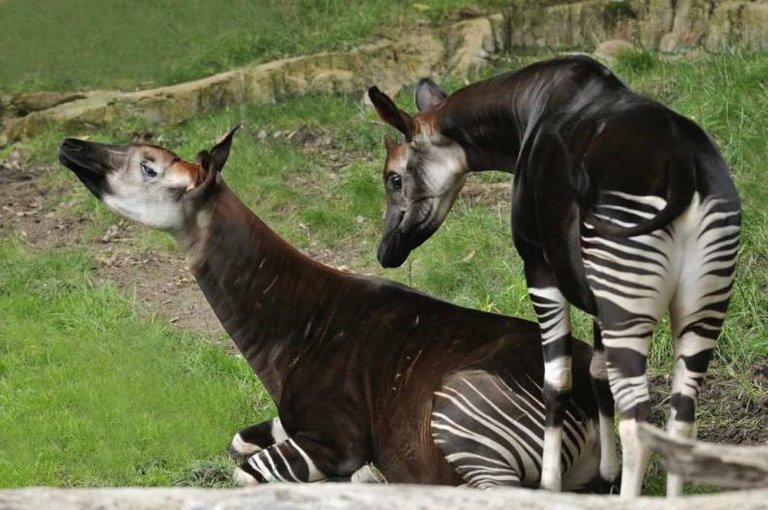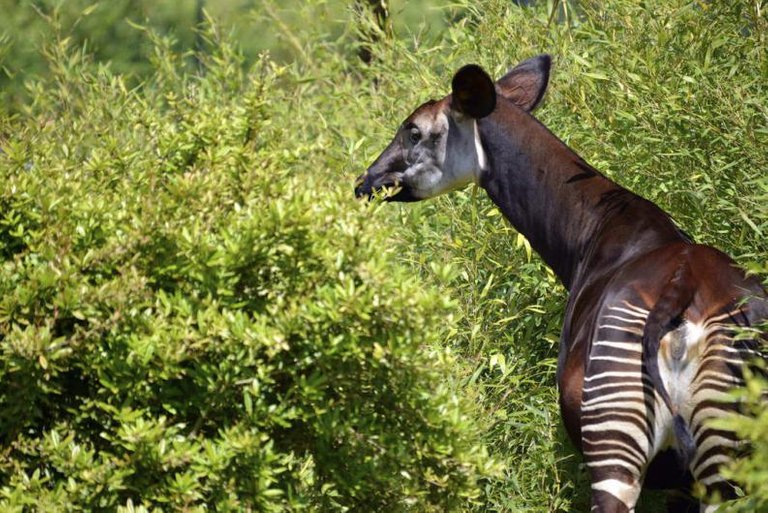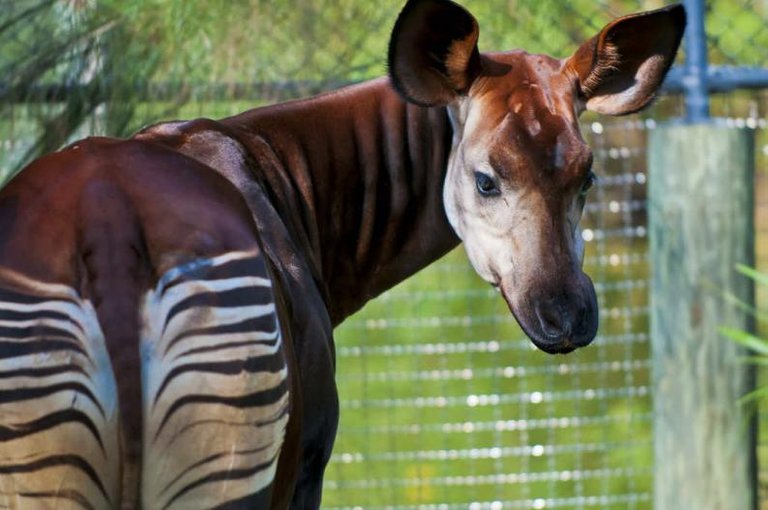The okapi (Okapia johnstoni), also known as forest giraffe, Congolese giraffe or zebra giraffe, is an artiodactyl mammal native to the northeast of the Democratic Republic of the Congo in Central Africa. Although the okapi has striped markings reminiscent of zebras, it is more closely related to the giraffe. The okapi and the giraffe are the only living members of the Giraffidae family. It has a long neck and large, flexible ears. Its fur is chocolate brown to reddish brown, very contrast to white horizontal stripes and rings on white legs and ankles. The male okapis have short, hair-covered protuberances, similar to horns on their heads called osicones, less than 15 cm (5.9 inches) in length. The females have spirals of hair and ossicons are absent.
Okapis are mainly diurnal, but they can be active for a few hours in the dark. They are essentially solitary, they only come together to reproduce. Okapis are herbivores and feed on leaves and buds of trees, herbs, ferns, fungi and fruits. Rut in men and estrus in women does not depend on the season. In captivity, heat cycles are repeated every 15 days. Minors are kept hidden and breastfeeding is carried out infrequently. Children begin to take solid food after three months and weaning takes place after six months.

Okapis inhabit canopy forests at elevations of 500-1,500 m (1,600-4,900 ft). They are endemic (Endemic can be understood: in biology, an endemism, a biological species or taxon that is found exclusively in a given biome, in medicine, an endemic disease, a disease that occurs systematically, regularly, and without appreciable variations). the tropical forests of the Democratic Republic of the Congo, where they occur in the central, northern and eastern regions. The International Union for the Conservation of Nature and Natural Resources classifies okapi as endangered. The main threats include the loss of habitat due to logging and human settlement. Extensive hunting of meat and skin of wild animals and illegal mining have also led to a decline in population. The Okapi Conservation Project was established in 1987 to protect okapi populations.
The first members of the Giraffidae appeared for the first time in the early Miocene in Africa, after having diverged from the superficially similar to deer climacoceratids. The giraffes spread to Europe and Asia in the mid-Miocene in a first radiation. Another radiation began in the Pliocene, but was interrupted by a decline in diversity in the Pleistocene. [14] Several important primitive giraffes existed more or less contemporaneously in the Miocene (23-10 million years ago), including Canthumeryx, Giraffokeryx, Palaeotragus and Samotherium. According to the paleontologist and author Kathleen Hunt, Samotherium, it was divided into Okapia (18 million years ago) and Giraffa (12 million years ago). [15] However, J. D. Skinner argued that Canthumeryx gave rise to the okapi and giraffe through the last three genera and that okapi is the existing form of Palaeotragus. [16] The okapi is sometimes referred to as an example of a living fossil, since it has existed as a species for a long period of geological time, and morphologically resembles more primitive forms (eg, Samotherium).

The okapi, a complicated animal to protect!
The striking and strange aspect of the okapi made that, after its discovery and recognition as a species by the scientific community a little more than a hundred years ago, zoos from all over the world undertook a strong campaign to obtain specimens from the wild for their exhibitions. This caused the death of many animals that could not stand long journeys and inadequate conditions. Although there are currently no reliable estimates of the size of their populations due to lack of studies, experts agree that okapi is a threatened species due mainly to the loss of habitat due to deforestation and human settlements, which constantly reduces its distribution area and its number, especially since the 1980s.

It seems unfair that this is happening, because they are also living beings and have a life ahead of us, just imagine that the animals were against us ... It would be very cruel to live for a species that you do not know and come kill you because you're hungry.
Make friends we are going to be fair and help to form those cute Okapi species that will come so they have a beautiful reproduction and multiply.
Read more:
https://www.vix.com/es/btg/curiosidades/5578/el-okapi-mitad-jirafa-mitad-cebra
You got a 12.75% upvote from @slimwhale courtesy of @mofeta!